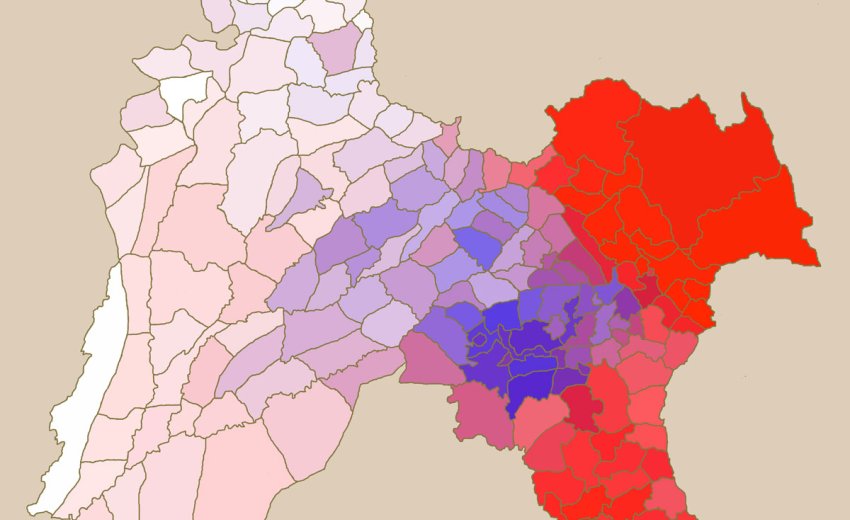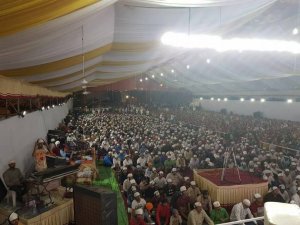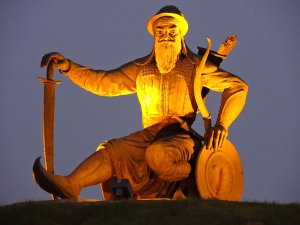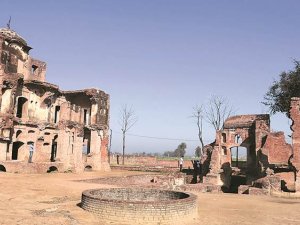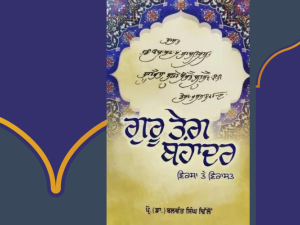THE SIKH IDENTITY in the post Khalsa Raj period
Introduction
The difference between Sikh and Hindu practices are obvious and well documented over the past 140 years. Following the annexation of Punjab and loss of royal patronage, the number of Sikhs started to decline rapidly. Sikhs were reverting back to Hindu practices and if a generation had become non Keshdhari then they would start using 'Kumar' instead of Singh and by the next generation they identified themselves as Hindus. This was particularly true for non Jatt community. The Singh Sabha Movement came in the 1870s, and the Lahore branch did a tremendous work in eradicating the non-Sikh practices based on Gurbani.
Milestones
Three milestones during the early 19th century late and early 20th century worth mentioning for they laid down the foundation of the separate Sikh identity in the post Khalsa Raj period when this identity was consistently been challenged.
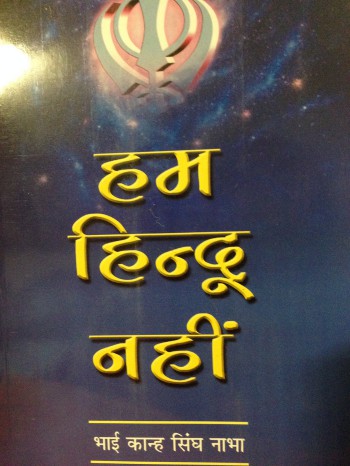 In 1897, Bhai Kahn Singh Nabha wrote his Ham Hindu Nahin in Hindi, to be followed by the Gurmukhi version, to question the Hindu contention and to explain how Sikhs were distinct from Hindus. By the time the fifth revised and enlarged edition of this work in Gurmukhi in 1920 was published, the Sikh position 'seemed clearly articulated and established.'1
In 1897, Bhai Kahn Singh Nabha wrote his Ham Hindu Nahin in Hindi, to be followed by the Gurmukhi version, to question the Hindu contention and to explain how Sikhs were distinct from Hindus. By the time the fifth revised and enlarged edition of this work in Gurmukhi in 1920 was published, the Sikh position 'seemed clearly articulated and established.'1
On 1st May 1905, the manager (sarbarah) of Harmandir Sahib at Amritsar, Sardar Arur Singh, issued orders prohibiting the Brahmans from sitting in the parikrama with their idols for worship and also forbade them from washing their clothes in the tank, besides spitting and rinsing their mouth in it. John Malcolm who wrote 'Sketch of the Sikhs' in 1811 mentions his visit to Harmandir Sahib and does not makes reference to any idols. This practice must have started sometime after 1849, post Punjab annexation by the British. Interestingly, despite popular belief, there is no evidence that there were idols in the main Prakash Sthan at Harmandir Sahib.
An important concern of the Singh Sabha reformers was the Sikh marriage rituals. Despite lot of Gurbani teaching and preaching, still some Keshdhari Sikh marriages were being conducted under Hindu rituals. The 'rebel' Maharaja of Nabha, Tikka Ripudaman Singh, before he was removed by the British, introduced Anand Marriage Bill in the Imperial Legislative Council in 1908 to give legal recognition to the Sikh ceremony of marriage. This paved the way to formal recognition and wider acceptance to the Sikh marriage ceremony.
'Double Hindus'2
During this period Sikhs were called 'double' or 'real' Hindus as they are Keshdhari and follow 'Vedas' that propagate monotheism and are against idol worship and casteism. Although no evidence was provided in terms of direct quotations from the Vedas, the author feels that if this is the case then all Hindus should shun their old practices and convert to Sikhism.
The author would like to share a very interesting perspective from a Hindu on the issue of identity. Gulshan Rai, who wrote 'The Hindu Problem in the Punjab' in 1934 gives a useful insight into how he sees the whole situation. Referring to the Arya Samaj, Gulshan Rai remarked that a protesting section of the Hindu community began to publicly ridicule and abuse the Sikh Gurus and offend the Sikh community. These differences between the Hindus and the Sikhs were fully exploited by the Europeans who tried to interpret the sacred books of the Sikhs in such a manner as to induce them to believe that they were not a reforming body within Hinduism, but an altogether separate community. As a result, the Sikh community, an overwhelming majority of who were Jats, a military caste, went out of the Hindu fold. From the military point of view it had been a great blow to the Hindus says Gulshan Rai.3
Our understanding of the religion grew and in some way changed during the period as more emphasis was given to Gurbani rather than customs and practices. Not only Arya Samaj, but many conservative Sikhs as well opposed these three remarkable paradigm shifting events. This had a positive impact. People became more aware of their separate identity, the number of Sikhs in Punjab increased from 8% to 14.9% from 1881 to 1941.4
Post partition
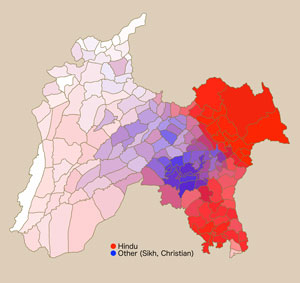 The struggle for a Punjabi speaking province and overwhelming resistance to this movement by a certain section of Hindu community along with the tragic events of eighties and nineties meant that most Hindus overwhelmingly see Sikhs as a separate nation. We now have the slogans like 'Hindu, Muslim, Sikh, Easaee hum sab hai bhai bhai (Hindu, Muslim, Sikh, Christian we are all brothers). At the Gurpurab commemorating the martyrdom of Guru Teg Bahadur, the write up in the major dailies commended Guru Ji's laying down his life for another religion. This is far cry from the late 19th century when we were told that Guru Ji gave his life for Hindus because he was a Hindu himself. The media does not portray Sikhs as Hindus, although the Bollywood depiction of Sikhs leaves much to be desired.
The struggle for a Punjabi speaking province and overwhelming resistance to this movement by a certain section of Hindu community along with the tragic events of eighties and nineties meant that most Hindus overwhelmingly see Sikhs as a separate nation. We now have the slogans like 'Hindu, Muslim, Sikh, Easaee hum sab hai bhai bhai (Hindu, Muslim, Sikh, Christian we are all brothers). At the Gurpurab commemorating the martyrdom of Guru Teg Bahadur, the write up in the major dailies commended Guru Ji's laying down his life for another religion. This is far cry from the late 19th century when we were told that Guru Ji gave his life for Hindus because he was a Hindu himself. The media does not portray Sikhs as Hindus, although the Bollywood depiction of Sikhs leaves much to be desired.
An unfortunate consequence
There were number of Hindu families in Punjab who made their eldest son a Sikh. Most of this generation are at least 60 years old now. The sad events in Punjab in 1980s & 90s meant that 95% of these Sikhs from Hindu families have reverted back to Hinduism - basically the next generation are clean shaven, use Kumar rather than Singh, and consider themselves as Hindus. The author attended a wedding about 14 years ago where the father was Keshdhari Sikh and had a surname of Singh Sharma but the son who was clean shaven had the surname Kumar Sharma. The marriage was conducted with Hindu rituals. When the whole extended family identifies with the Hindu religion one can assume that it is difficult to survive as a 'separate' entity.
Then there were Hindu families who would recite Gurbani and would go to Gurdwaras regularly. They have been called Mona or Sehajdhari Sikhs, but these people would also undertake the Puja rituals and veneration of Hindu Gods and Goddesses. It would be wrong to call them anything but Hindus who also recited Gurbani. The number of people under this categorisation has drastically reduced, but there are still a small number of them and the next generation is far less keen on it. Nevertheless some Hindus are very flexible. They will go to Hindu Temple, Dargah, Gurdwara and any other place. This trait is shared by some Sikhs, which is evident from the number of Deras and Babas in Punjab.
Even before partition there were others could not make the smooth transition from being a Hindu to Sikh. Sardar Prithipal Singh Kapur shared his experience "My grandfather was attracted to Sikhism under the influence of his wife who was a regular reciter of the Granth. The couple decided to initiate their sons into the Khalsa fold. The consequence was distancing of the entire Kapur gotra people from our family and my grandparents did not find themselves comfortable with that. None of their sons could get a bride from within the Dhai Ghara Khatri castes as per caste hierarchical tradition."5
A Sikh youngster living in the west will find it very hard to understand this paradox. One may mention that 70% of Sikh youth in Punjab are Patit and very few can read Gurbani. This cross-over was nevertheless a part and parcel of our history which we cannot deny.
Making a positive contribution - talk to your friends
The radical right wing sections like RSS and its affiliates which are considered Hindu organisations still portray Sikhs are Hindus. Our reluctance to have this difficult conversation is baffling. This issue that Sikhs are not Hindus is core to almost all Sikhs to varying degrees whether they subscribe to a separate country or not. Sikhs in the western hemisphere do not sometimes understand that in Punjab and India we have a mutual dependent society where a neighbour is the first one to help you as the state, compared to the west, is non-existent. At every stage one needs help and support from others. Conversely one provides the same. Hence you will have close Sikh-Hindu friendships even among people who do not have mixed Hindu Sikh relatives. And among these people, invariably out of affection, the Hindu will believe that Sikhs are part and parcel of Hindus and the Sikh friend will not correct them. I have asked number of Sikh gentlemen if they have asked their Hindu friends about it, surprisingly none have. A friend or a relative is the best person to have this difficult conversation with. One can influence them and help them see your point of view.
Once the author realised he himself was a culprit of it, he had discussions with close friends. The atrocities committed by Mughals and Abdali were remembered but Sikhs are actually more bothered and hurt about the killings which happened in this generation.
Another argument was given that Khalsa was created to protect Hindus but it was not fair of Arya Samajis to use this argument in early 20th century and twist it on the lines that Hindus are no longer in danger hence there is no need for Khalsa. The infamous 'Shuddi movement' by them to convert Muslims to Hindus, also converted Sikhs to Hindus. The author has met descendants of these 'converted people', they follow all Hindu rituals but marriages are conducted as per Sikh 'Anand Karaj' tenets.
Another argument given pertained to Hindus' and Sikhs' relations with Muslims, e.g., how the latter do not marry with the former, while mixed marriages between the formers are still not uncommon in Punjab. These mixed marriages were more prevalent in the Khatri community. Previously they were arranged by parents and now they are 'arranged' by youngsters themselves, so called love marriages.
The author proposed that the comparison itself is wrong, Sikh-Hindu relations should be compared with Hindu-Buddhist relations. This hypothesis has its own downside because RSS considers all Indian religions including Buddhism as part of Hinduism, and Buddha was simply added as an incarnation of Vishnu. However these two assertions do not find any supporters among Buddhists who are a majority religion in Sri Lanka, Burma, and Cambodia among other countries. There is lot of overlap between Judaism and Islam, but do we need animosity to that level before we will be considered separate? There are similarities among Abrahamic religions and Eastern religions but there are differences as well. Instead of saying Sikhs are Hindus why can't the RSS say something along the lines of "Hindus have special relationship with Sikhs but they are a separate religion."
Moving forward
The Akali Dal, headed by Prakash Singh Badal, has been a staunch ally of the BJP, the political wing of the RSS, since 1996. Even if we ignore the earlier short lived Akali -Jan Sangh (former avatar of BJP,) these allies have ruled together for close to three full terms, i.e. 15 years. The Badals might use their good offices with the BJP to influence the RSS to declare that Hindus have a special relationship with Sikhs but that they are two separate religions. By achieving this change the Akali government will be able to address at least one of the many major issues concerning Sikhs.
This could be followed by amending the Article 25(b) of the constitution which refers to Sikhs, Buddhists and Jains as Hindus. Rather than saying Hindu, the constitution may use the terminology of Indian religions namely Sikhs, Hindus, Buddhist and Jains. A consensus needs to be built with other parties namely Jains and Buddhists. Sadly the Akali government has not raised either of these issues during last 20 years.
I believe that ahead of the Punjab Assembly Election in 2017, Sikh organisations should ask all parties in Punjab to commit that they will bring forward the bill to amend Article 25(b) in Parliament prior to voting for them. Sardar Tarlochan Singh brought this bill twice in the Rajya Sabha but it was not discussed and the Akali showed no interest in it.
Conclusion
The Muslim Rajputs in Pakistan are very proud of their heritage, however they are Muslims, and will ferociously argue against it if someone suggests they are Hindus. The history of the region is fascinating. Among Punjabis there were once huge communities of Jains, Buddhist, Indo-Greek, and Parthians and now there are Hindus, Sikhs and Muslims. Guru Nanak was born a Hindu and Mardana a Muslim. A Muslim Sufi (Mian Mir) laid the cornerstone of the Harmandir Sahib. There is no need to deny the common heritage nor should one refuse to acknowledge others' separate identity.
References
1. Sheena Pall: Issues of Sikh Identity: Sanatanist- Sikh Debate, Journal of Punjab Studies Vol 20:1
2. Pandit Sukhlal: Guru Sahibon ka Dharm (Hindi), (Lahore: Basant Printing Press, 1936),
3. Gulshan Rai: The Hindu Problem in the Punjab (Lahore: Sanatan Dharm Collage, 1934) in Sheena Pall: Issues of Sikh Identity: Sanatanist- Sikh Debate
4. Gopal Krishnan: Demography of Punjab (1849-1947), Journal of Punjab Studies, Vol 11:1
5. Prologue by Prithipal Singh Kapur in First Punjab War, Shah Mohammed's Jangnamah by PK Nijhawan, Punjabi University, 2000
*The author is Nottingham based amateur historian with a keen interest to share important but lesser known facts about Sikh & Punjab history.
